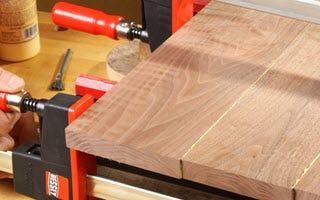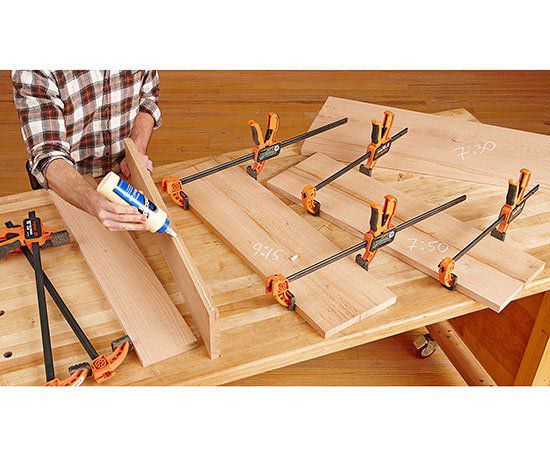When it comes to woodworking and DIY projects, understanding how to properly clamp wood glue is essential. So, how long do you have to clamp wood glue? Let’s dive in and find out!
When you’re using wood glue, it’s important to allow enough time for it to set and dry properly. The amount of time will depend on various factors, such as the type of wood glue you’re using and the environmental conditions.
So, why is clamping important? Well, clamping helps to ensure a strong bond between the wood pieces, preventing any movement or gaps as the glue dries. This creates a sturdy and reliable final product.
Now that we know the importance of clamping, let’s explore the timeline for different types of wood glue. So, grab your clamps and let’s get started on our woodworking journey!

How Long Do You Have to Clamp Wood Glue?
When working on woodworking projects, one important step is applying wood glue to ensure strong and durable joints. But how long do you have to clamp the wood glue before it sets? In this article, we will explore the optimal clamping time for wood glue and provide you with some helpful tips to achieve the best results.
The Importance of Clamping Time
Clamping time refers to the period during which the wood glue needs to be held in place with clamps to allow it to dry and form a strong bond between the pieces of wood. This step is crucial for ensuring the stability and durability of the finished project. If the clamps are removed too early, the joint may weaken, leading to potential failure and a disappointing outcome.
The recommended clamping time for most wood glues is around 30 minutes to 1 hour. However, it’s worth noting that different factors can affect the drying time, such as temperature, humidity, and the type of wood glue used. Always refer to the manufacturer’s instructions for precise clamping time recommendations.
It’s important to keep in mind that clamping too long can also have negative effects. If you leave the clamps on for an excessive amount of time, the excess glue may squeeze out and harden, making it difficult to remove and potentially marring the appearance of the project. Therefore, it’s essential to find the right balance and remove the clamps at the appropriate time.
Factors Affecting Clamping Time
As mentioned earlier, several factors can influence the clamping time required for wood glue to fully set. Let’s take a closer look at these factors and how they can impact your woodworking projects:
1. Type of Wood Glue:
There are different types of wood glue available, such as PVA (polyvinyl acetate) glue, epoxy glue, and polyurethane glue. Each type has its own specific clamping time, so make sure to refer to the instructions provided by the manufacturer.
2. Temperature and Humidity:
The temperature and humidity levels in your workspace can significantly affect the drying time of wood glue. Higher temperatures can accelerate the drying process, while lower temperatures can slow it down. Similarly, high humidity levels can prolong the drying time.
3. Type of Wood:
Some types of wood, like hardwoods, may have a more porous surface, which can absorb more moisture from the glue. This can affect the clamping time, so take into account the type of wood you are working with.
Tips for Achieving Optimal Clamping Results
To ensure the best results when clamping wood glue, here are some valuable tips to follow:
1. Prepare the Surfaces:
Make sure the surfaces being glued are clean, dry, and free from any debris or dust. This will ensure better adhesion and a stronger bond.
2. Apply the Right Amount of Glue:
Applying too little glue can result in a weak bond, while applying too much can lead to excessive squeeze-out. Use a brush or roller to spread an even layer of glue on both mating surfaces.
3. Use the Right Clamps:
Choose clamps that are appropriate for the size and shape of your project. Ensure they apply even pressure across the entire joint and avoid overtightening, which can squeeze out too much glue.
4. Monitor the Clamping Time:
Keep track of the recommended clamping time and set a timer to ensure you don’t remove the clamps too early or leave them on for too long. This will help you achieve the strongest bond.
5. Clean Up Excess Glue:
After removing the clamps, carefully scrape off any excess glue with a chisel or a putty knife. It’s easier to clean up while the glue is still somewhat pliable.
Choosing the Right Wood Glue:
When determining how long to clamp wood glue, it’s essential to choose the right type of glue for your project. Here are a few popular options:
1. PVA Glue:
PVA (polyvinyl acetate) glue is the most commonly used wood glue. It has a relatively short clamping time of about 30 minutes to 1 hour and provides a strong bond for most woodworking applications.
2. Epoxy Glue:
Epoxy glue offers exceptional strength and durability. It has a longer clamping time of around 1 to 2 hours, but it provides a waterproof bond and is ideal for outdoor projects or projects exposed to moisture.
3. Polyurethane Glue:
Polyurethane glue is known for its excellent bonding strength and flexibility. It has a longer clamping time, typically around 2 to 4 hours, but it expands as it cures, filling gaps in the wood for an even stronger bond.
Common FAQs About Clamping Wood Glue:
Here are some frequently asked questions about clamping wood glue:
1. Can I shorten the clamping time for wood glue?
While it’s not recommended to shorten the recommended clamping time, certain wood glues offer fast-drying formulas that allow for shorter clamp times. Look for products specifically designed for quick bonding if you’re in a time crunch.
2. Do I need clamps for every woodworking project?
While clamps are essential for projects that require a strong bond, not every project requires clamping. If you’re working on a smaller project with lightweight materials, you may be able to apply pressure by hand or use tape to hold the pieces together while the glue sets.
3. Can I use too many clamps?
Using multiple clamps can help distribute pressure evenly across the joint, but be careful not to overdo it. Applying excessive pressure can squeeze out too much glue and potentially weaken the bond. Follow the recommendations provided by the glue manufacturer.
To achieve the best results with wood glue, it’s crucial to understand the optimal clamping time and follow the manufacturer’s instructions. By choosing the right type of glue, preparing the surfaces properly, and using the appropriate clamping technique, you can ensure strong and durable joints in your woodworking projects. Remember to keep an eye on the clamping time and clean up any excess glue for a professional and clean finish. Happy woodworking!
Key Takeaways: How Long Do You Have to Clamp Wood Glue?
- Wood glue generally requires clamping for at least 30 minutes to ensure a secure bond.
- For maximum strength, experts recommend leaving the clamps on for 24 hours.
- Always follow the manufacturer’s instructions, as drying times can vary depending on the type of wood glue used.
- Applying even pressure with clamps helps prevent excess glue from squeezing out.
- If you need to use the clamped object before the full drying time, consult the glue’s instructions for safe handling and curing times.
Frequently Asked Questions
Wood glue is an essential adhesive used in woodworking projects. One common question that arises when using wood glue is how long it needs to be clamped for proper bonding. In this section, we will answer some frequently asked questions related to the clamping time for wood glue.
How long should wood glue be clamped for?
When using wood glue, it is essential to clamp the glued pieces together to ensure a strong bond. The recommended clamping time for most wood glues is around 30 minutes to 1 hour.
During this time, the glue cures and hardens, creating a firm bond. However, it is always a good idea to refer to the specific instructions provided by the manufacturer of the wood glue you are using, as different glues may have slightly different clamping times.
What happens if you don’t clamp wood glue?
If you don’t clamp wood glue, the bond between the glued pieces may not be as strong as desired. Clamping helps to keep the pieces in place while the glue dries, preventing any movement that could weaken the bond.
Without clamping, the glued pieces may shift or separate, resulting in a weaker joint. Additionally, clamping helps to ensure that the pressure is evenly distributed across the glued surfaces, promoting better adhesion and a stronger bond.
Can you remove the clamps before the recommended clamping time?
It is generally not recommended to remove the clamps before the recommended clamping time specified by the wood glue manufacturer. Removing the clamps prematurely can disrupt the curing process and compromise the strength of the bond.
While the glue may appear dry on the surface, it may still need more time to fully cure and develop its maximum strength. It is best to follow the manufacturer’s guidelines and leave the clamps in place for the recommended duration to ensure a durable bond.
Is overnight clamping necessary for wood glue?
Overnight clamping is not always necessary for wood glue, as most wood glues reach their initial strength within the first few hours. However, if you want to ensure the strongest possible bond, leaving the clamps overnight can provide additional assurance.
Keep in mind that the exact clamping time may vary depending on the specific type of wood glue you are using. Therefore, it is essential to consult the instructions provided by the manufacturer to determine the recommended duration of clamping for optimal results.
Can you apply too much pressure when clamping wood glue?
Applying excessive pressure when clamping wood glue can actually be detrimental to the bonding process. Too much pressure can cause the glue to squeeze out excessively and result in weak joints.
It is important to apply firm, even pressure when clamping, ensuring that the pieces are held firmly together without excessive squeezing. Following the manufacturer’s guidelines on clamping pressure is crucial for achieving a strong and durable bond.

How long does wood glue take to cure.?!?!
Summary
When using wood glue, it’s important to know how long to clamp it. Clamping helps create a strong bond, but keeping it on for too long can cause issues. Generally, you should clamp the wood glue for about 30 minutes to an hour. This allows the glue to dry and set properly. However, different types of wood glue may have different drying times, so it’s essential to read the instructions on the glue bottle. Too little clamping time can result in weak joints, while too much time can squeeze out too much glue and lead to messy projects. So, finding the right balance is crucial for a successful woodworking project.
It’s also important to note that the environmental conditions can affect the drying time of wood glue. If it’s humid or cold, the glue may take longer to dry. On the other hand, warm and dry conditions can speed up the drying process. So, make sure to consider the temperature and humidity when determining how long to clamp your wood glue. By following these guidelines, you’ll be well on your way to creating strong and sturdy woodwork projects.
